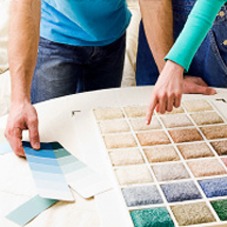Choosing The Right Carpet Fiber

Comparing Carpet Fibers
Although some carpets are made of blends, most are made entirely of one of the following four fibers:
| Fiber | NYLON | PET | PTT | Polypropylene |
| Style Options | Excellent | Excellent | Fair | Fair |
| Color Options | Excellent | Excellent | Good | Fair |
| Soil Resistance | Excellent | Excellent | Fair | Poor |
| Stain Resistance | Excellent | Excellent | Excellent | Excellent |
| Texture Retention | Excellent | Excellent | Good | Fair |
Nylon Carpet Fibers
In overall performance characteristics, nylon is one of the most versatile of all fibers, providing excellent durability and flexibility in creating a variety of carpet styles. Nylon is the most commonly used carpet fiber and can be found in a wide range of both cut pile and loop pile styles. Nylon also has great color flexibility and uniformity, and many nylon yarn systems are exceptionally soft. Though not inherently stain resistant, branded carpets made with nylon feature a stain-resist carpet treatment for protection against household spills and stains.
The carpet mills in Dalton, Georgia have premium branded nylon carpets designed to have a positive impact on both people and the environment. The certification process looks at a number of factors, including the use of environmentally safe and healthy materials, design for recycling, water, and energy efficiency, and social responsibility.
Polyester (PET) Carpet Fibers
Polyester offers exceptional softness and color clarity and is also naturally stain and fade resistant. Polyester can be as versatile as nylon, many carpets made of polyester fiber perform very well. PET carpets are considered to be the most environmentally friendly carpets carried within the Denver carpet industry. The soft texture and affordability of this fiber are often what draws many consumers to make this an easy choice for home carpeting.
Polypropylene (olefin) Carpet Fibers
Unlike other fiber types, polypropylene will not absorb water, so it is solution dyed. Solution dyeing is a process in which color is actually built into the fiber when it is formed making the color an inherent part that cannot be removed from the fiber. This means the color will not fade, even when exposed to intense sunlight, bleaches, atmospheric contaminants, or other harsh chemicals or elements.
Polypropylene is normally used in loop pile construction in which there is less need for resiliency because it is not as strong as other fibers.
of the company’s Corterra polymers was possible. Shaw introduced the first BCF PTT (Corterra) residential carpet in the United States in 2001. PTT features good resiliency and excellent inherent stain resistance. Recently, some manufacturers have begun applying a topical treatment to PTT carpets. While adequate for staining, PTT still attracts dry and oily soil substances, leading to premature wear in high traffic areas. For this reason, many oil-based stains are extremely difficult to remove.

